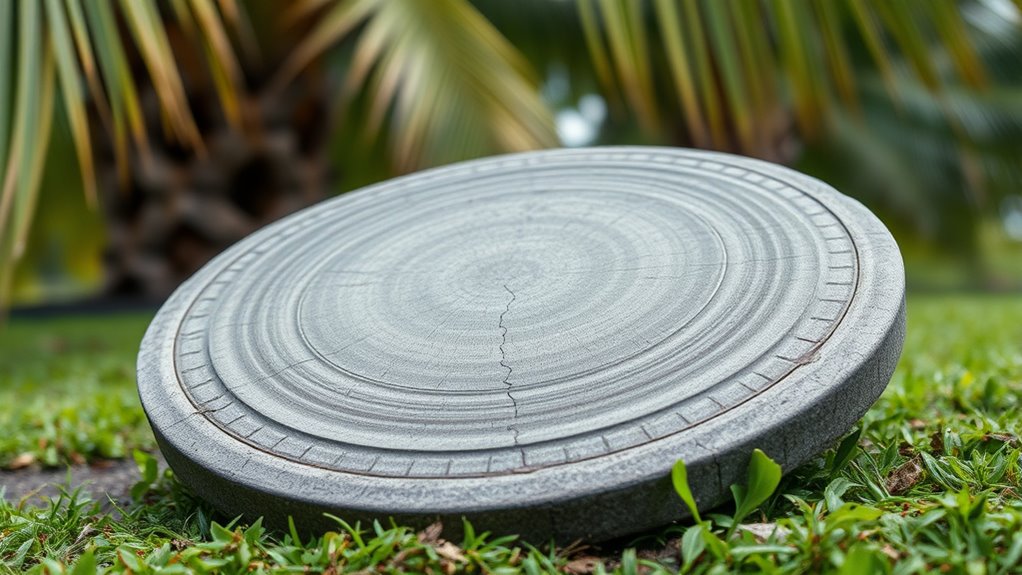Yap’s stone money, large disks weighing up to four tons, still functions as currency because its value isn’t based on physical possession but social recognition. The community acknowledges ownership through tradition and consensus, not movement. These stones symbolize social status and cultural identity, often exchanged in ceremonies rather than used as everyday money. If you want to discover how these impressive disks maintain their significance today, there’s more to explore below.
Key Takeaways
- Yap’s stone money symbolizes social status and cultural identity, emphasizing trust and community consensus over physical possession.
- The disks are not always physically exchanged; their value is socially recognized during ceremonies and negotiations.
- They serve as cultural artifacts linked to ancestors, reinforcing tradition and continuity across generations.
- Despite no longer being everyday currency, they influence social interactions and decisions within Yap society.
- The stone disks exemplify a form of wealth rooted in social bonds, history, and cultural significance rather than monetary exchange.

Yap’s stone money is a fascinating form of currency that has persisted for centuries on the Micronesian island of Yap. These massive, circular disks, some weighing up to four tons, are more than just physical objects; they embody a deep sense of history and cultural identity. Their historical significance is profound, rooted in traditional practices that date back hundreds of years. Originally, these stones weren’t just used for trade; they signified social status, wealth, and political power. When you encounter Yap’s stone money, you’re stepping into a world where currency transcends mere monetary exchange, becoming a symbol of community and history. The stones’ importance isn’t just in their size or rarity but in what they represent: a tangible connection to the island’s ancestors and their way of life. Over generations, these disks have been passed down, exchanged, and used in various ceremonies, cementing their role as cultural symbols. You might notice that the stones aren’t always moved physically during transactions; instead, their value is acknowledged through oral agreements and social consensus. This tradition highlights the communal nature of Yapese society, emphasizing trust and social bonds over the physical possession of the disk itself. Additionally, the cultural symbolism of Yap’s stone money is deeply woven into the island’s social fabric. It’s a visual reminder of the islanders’ respect for tradition and their ancestors. These stones are often featured in important ceremonies, such as land negotiations or marriage alliances, reinforcing their role as carriers of cultural meaning. While the stones are no longer the primary currency for everyday transactions, their presence still influences social interactions and community decisions. When you see a large stone disk displayed or used in a ceremony, you’re witnessing a living tradition that links the present to the past. The stones serve as a reminder that wealth isn’t solely material but also rooted in social relationships, history, and cultural continuity. Understanding the significance of these disks offers insight into Yap’s unique worldview—one where history and culture are inseparable from economic life. So, as you explore this extraordinary form of currency, remember that Yap’s stone money isn’t just about the physical object; it’s a powerful symbol of identity, tradition, and enduring social bonds.
Frequently Asked Questions
How Are Disputes Over Stone Money Ownership Resolved?
When faced with ownership disputes over Yap’s stone money, you’ll find that resolution methods often involve community consensus and social acknowledgment. The community or elders typically mediate, relying on oral history and tradition to settle disagreements. Since physical possession isn’t always necessary, acknowledgment of ownership by the community suffices. This approach maintains social harmony and trust, ensuring disputes are resolved through consensus rather than legal or formal channels.
Can New Stone Disks Be Created or Replaced?
You might wonder if new stone disks can be created or replaced today. While traditional Yapese stone money relies on artificial replication for repairs or replacements, this isn’t common practice anymore. Modern currency methods, like digital or paper money, make physical replacement unnecessary. So, although you could technically produce new disks, they’d lack the cultural significance and authenticity of the original Yapese currency, which is mostly preserved as a cultural symbol now.
How Does the Community Determine the Value of Each Disk?
You see, the community determines the value of each stone disk through cultural symbolism and historical significance. It’s not just about size or appearance; the story behind each disk influences its worth. This cultural importance impacts the economic system, as the disks serve as a symbol of wealth and status. The community’s consensus, rooted in tradition, keeps the value stable, preserving both cultural identity and economic stability.
Are There Any Modern Equivalents to Yap’S Stone Money?
Modern banking and digital currencies serve as contemporary equivalents to Yap’s stone money. You can use your bank account or digital wallets to store and transfer value seamlessly across the globe. Just like Yap’s disks, these currencies rely on community trust and agreed-upon value, but they operate electronically, making transactions faster and more convenient. Digital currencies, in particular, are shaping the future of how you perceive and use money today.
What Cultural Significance Do the Disks Hold Today?
You see, these disks hold deep cultural significance today, symbolizing social status and communal history. They’re integral to cultural traditions and ceremonies, often used in important events like weddings or disputes to settle matters peacefully. Their ceremonial significance emphasizes respect for ancestral customs, preserving the islanders’ heritage. Though no longer used as everyday currency, the disks remain powerful symbols of identity and continuity within Yap’s community.
Conclusion
You see, Yap’s stone money isn’t just about the hefty disks; it’s a symbol of trust and community, enduring beyond mere material value. These stones remind you that true currency isn’t just about what’s exchanged but what’s held sacred in shared belief. As they remain central to Yap’s identity, they teach you that in life, some treasures—like trust and tradition—stand strong, anchoring communities through time, much like these timeless disks.








